
PREV ARTICLE
NEXT ARTICLE
FULL ISSUE
PREV FULL ISSUE
THE OVEREND WWI FRENCH MEDAL COLLECTIONHarry Waterson also published a great article in the October 2018 issue of The Clarion from the Pennsylvania Association of Numismatists. With permission, here is an excerpt. -Editor Collections are often very personal. This is about a collection of medals put together at the end of WWI in France by Captain Harrison G. Overend (1890-1957). 1 Harry Overend was born in Peoria, IL, attended Ipava High School and Bradley Polytechnic Institute - now Bradley University - in Peoria. He graduated from the University of Illinois in 1917 with a BS in Architecture. On August 15, 1917 he went on active duty as a 2nd Lt., 14th US Infantry, Vancouver Barracks, WA and on October 25th he was promoted to 1st Lt. in the Coast Artillery Corps (CAC) stationed at Ft. Warren in Boston harbor, MA. He was appointed temporary Captain on May 20th, 1918 in command of Battery B, 71 ST Artillery Regiment, CAC. The Regiment sailed on the SS Margha for Liverpool via Halifax July 31. They landed on August 15th, were held briefly at Camp Standon in Hertfordshire and then sailed for France from Southampton August 29th on the SS Charles arriving in Le Havre one day later. The 71 ST Artillery Regiment was assigned to Organization and Training Center No. 4 (O&TC) in St. Sylvain where they went into training with heavy guns both stationary and mounted on railroad cars. Still training when the Armistice was signed, they remained in France until February, 1919 when they sailed back to the US and were demobilized at Camp Devens, MA on March 6, 1919. Captain Overend did not return with his unit. On January 24, 1919 Overend was assigned as an Intelligence Officer to the American Embarkation Center, Le Mans, France. In the spring of 1919 Overend received a month's leave and went to Winchester, England where he spent his time in Winchester Cathedral making prints of inscriptions by rubbing a wax over tracing paper placed on the brasses. The four oldest brasses he traced dated from 1433 to 1494. He sent the tracings to the romance language department at the University of Kansas at Lawrence to be translated and made available to scholars. 2 Overend was an unusual young man. Harry Overend returned to the US on the SS Cap Finisterre sailing from Brest, France on August 7, 1919. He resigned his commission September 18, 1919 and moved to Wichita, KS where he joined the architectural practice of Lorentz Schmidt. Schmidt recruited fellow architectural graduates from the University of Illinois who were mostly members of the Alpha Rho Chi National Architectural fraternity. He recognized the six graduates who joined him in 1919 by changing the name of his firm in 1920 to Lorentz Schmidt & Company. It is easy to trace the career of Harry Overend by following the arc of the name changes of the firm. By the mid 1920s it was Schmidt, Boucher & Overend and by 1933 it was Overend & Boucher, Architects. Their practice centered on institutional buildings with the Diocese of Wichita and related Catholic organizations being the source of many major commissions. Harrison G. Overend married Pearl L Stewart in 1924 and they had one son, Donald Stewart in 1927. Harry Overend returned to the US from France with two collections. On the 13th of February, 1923 he exhibited his collection of French war posters for a program on commercial art at the Twentieth Century Club in Wichita. 3 The posters whereabouts today are unknown. He also collected a small number of medals which have managed to stay together to today. They went from father to son to the son's widow and will pass on to a grandchild still intact. This happens very rarely and the collection is well worth a close examination. What did Harry Overend choose to bring back out of all the memorabilia available to him in France? Joan of Arc, Liberator of the Land - 1900 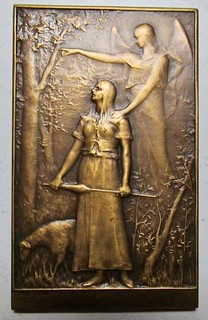 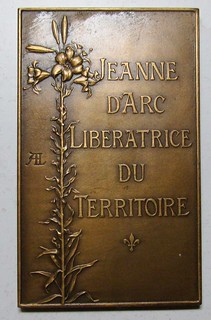 Jean-Baptiste Daniel-Dupuis (1849-1899) French sculptor. JEANNE D'ARC, LIBERATRICE DU TERRITOIRE. Joan of Arc, Liberator of the Land. Bronze plaquette, 67x40mm. Shows peasant girl among sheep with Michael the Archangel and leader of the angelic militia on a hill behind offering Joan guidance and direction. Last medal by Dupuis before his tragic death. Reverse by his friend Alphonse Lechevrel (1848-1924). Lechevrel used seven lilies three still in bud on a single stalk to symbolize the Lily Maid. Silver and looped versions are known. Joan of Arc was the French national saint who forced the English to abandon the siege of Orleans in 1429 during the Hundred Years' War. She also played a decisive role in the Coronation of Charles VII in Rheims. She was burned at the stake in 1431 as an alleged heretic. Daniel-Dupuis was one of the most important figures in the revival of medallic art in France. He was made Chevalier of the French Legion of Honour in 1881. He received a gold medal at the Universal Exhibition in Paris in 1889 and was promoted to Officer of the French Legion of Honour in 1891. In addition to an impressive number of medals and plaquettes, he also produced coins for France and Indochina, drawings paintings and watermarks for banknotes as well as statues and bas-reliefs, including works for the Hotel de Ville in Paris. The Women of the Red Cross - 1916 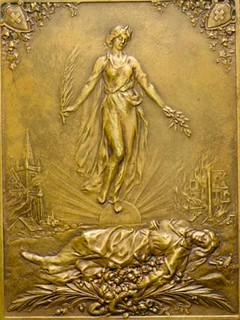 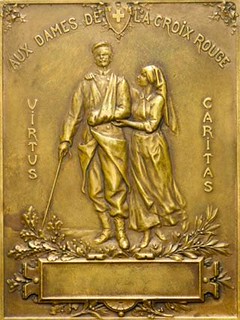 Henri Emile Allouard (1844-1929) French sculptor. AUX DAMES DE LA CROIX ROUGE The Women of the Red Cross, 70x52mm plaquette, bronze. Obverse: angel rising over a dead Red Cross nurse, pistol lying by her head dropped by a German soldier as he flees. Reverse: a Red Cross nurse aiding a wounded soldier flanked by the words Virtue and Charity. Cartouche below. The 'smoking gun' in the plaquette is a reference to the prominent nurse Edith Cavell (1865–1915). A British nurse she is celebrated for saving the lives of soldiers from both sides without discrimination. She helped some 200 Allied soldiers escape from German-occupied Belgium, for which she was arrested. She was accused of treason, found guilty by a court- martial and sentenced to death. Despite international pressure for mercy, she was shot by a German firing squad. Her execution received worldwide condemnation. The night before her execution, she said "Patriotism is not enough. I must have no hatred or bitterness towards anyone." These words were later inscribed on a memorial to her near Trafalgar Square. Her strong Anglican beliefs propelled her to help all those who needed it, both German and Allied soldiers. She was quoted as saying, "I can’t stop while there are lives to be saved." Henri Allouard was known for his combinations of polychrome marbles and bronze, he also worked in terracotta, ivory and precious metals. He was the author of sets painted at the Parthenon, at the Paris Opera and at the City Hall of Paris. He was representative of the of the neo-baroque influence in sculpture. The Battle of Verdun - 1917 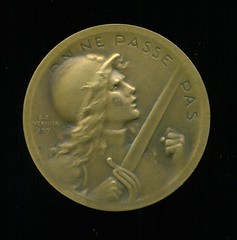 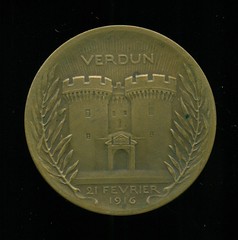 Emile-Seraphin Vernier (1852-1927) French sculptor. The Battle of Verdun medal (Feb.21, 1916 - Dec. 18, 1916) Bronze, 26mm looped. Issued in 1917 to all who participated in the battle by the City of Verdun to commemorate the city's defense. Later the distribution of the medal was expanded to anyone who served on the Argonne and St. Mihiel sectors between 31 July 1914 and 11 November 1918. ON NE PASSE PAS. "They shall not pass." is a quote from a speech by General Robert Nivelle to his troops on June 23, 1916. The medals, medalets and plaquettes have been organized in chronological order. When this was done the writer was struck by the narrative he got from these lovely pieces of bronze, all but one signed by the talented French sculptors who created them. They were collected by a soldier who saw the parallel in the 15th Century liberation of France by an almost mystical intervention and the 20th Century liberation of France by the massive intervention of the American Expeditionary Force (AEF). The 1908 Victory plaquette is one that would acknowledge achievement in sports or scholarship, not the battlefield. The run from 1915 to 1918 graphically depicts the horrors the French had endured since the German invasion. They had to defend their homeland, care for their wounded, send husbands and sons to fight and die, fight battles, including one that lasted almost a year. Finally with the intervention of the AEF, victory. Hence the French victory medal that shows the American influence. This collection does not seem like a haphazard potpourri picked up in an afternoon but rather one thoughtful soldier's careful assembly of pieces chosen to reflect his thoughts and ideas about his experience of the Great War. This writer is ever grateful that he had a chance to look at and hold these medals 100 years after Harry Overend gathered them together, put them in a box and brought them back to Kansas. THE BOOK BAZARREWayne Homren, Editor The Numismatic Bibliomania Society is a non-profit organization promoting numismatic literature. See our web site at coinbooks.org. To submit items for publication in The E-Sylum, write to the Editor at this address: whomren@gmail.com To subscribe go to: https://my.binhost.com/lists/listinfo/esylum All Rights Reserved. NBS Home Page Contact the NBS webmaster 
|